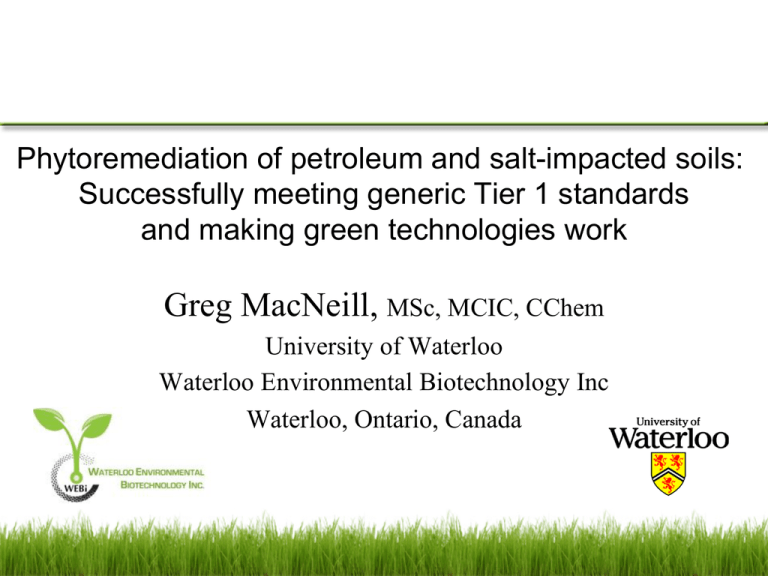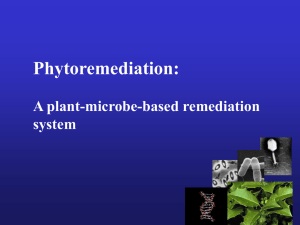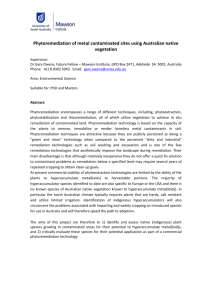Phytoremediation of petroleum and salt
advertisement

Phytoremediation of petroleum and salt-impacted soils: Successfully meeting generic Tier 1 standards and making green technologies work Greg MacNeill, MSc, MCIC, CChem University of Waterloo Waterloo Environmental Biotechnology Inc Waterloo, Ontario, Canada Advantages of Phytoremediation 1. Improves the quality of soil 2. It is cost effective, technically feasible and proven 3. Plants provide sufficient microbial biomass for rapid remediation; promotes high rhizosphere activity 4. Reasonable time frames – 2 to 4 years 5. Effective for remediation of petroleum hydrocarbons (PHC) and salt – Relevant to the energy industry 6. Decrease the amount of soil destined for landfills PGPR Enhanced Phytoremediation System (PEPS) Physical soil treatment: Seed bed preparation Phytoremediation: Growth of plants with PGPR Monitoring and remediation assessment: Environmental chemistry to follow PEPS from start to finish • PGPR: Plant growth promoting rhizobacteria. • PGPR are applied to the grass seeds prior to sowing → NOT Bioaugmentation Interaction of a PGPR Containing ACC Deaminase with a Plant Seed or Root Naturally occurring, non-pathogenic microbes (usually Pseudomonads) Amino Acids Cell Elongation and Proliferation IAA Amino Acids IAA SAM Chosen initially based on ACC Deaminase activity and auxin (IAA) production ACC Synthase ACC ACC ACC Deaminase Ethylene Ammonia and α-­‐Ketobutyrate Bacterium Stress Response Plant Tissue Adapted from Glick et al, 2004 We have isolated PGPR from ON, AB, SK and the NWT (native to North America) Can be isolated from soils anywhere Effect of PEPS on Soil Microbial Community No statistical difference between plots with and without PGPR Increase in bacterial count seen with plants History of the Development of PEPS Over 13 years of research with full-scale field remediations at each stage of development and application 1. PHC: sites in AB, BC, QC, MB, NWT and ON (2004-13) 2. Salt: sites in SK, MB, AB and NWT (2007-13) Performing full scale remediations for over 8 years PEPS currently operating at over 30 sites Over 10 sites completed Grasses (annual and perennial), oats and fall rye Remediation observed to depth of 18 – 36 inches PGPR Seed Treatment PGPR-treated seeds assayed for plant growth enhancement to assure successful PGPR application North BC – Before PEPS Treatment (May 2009) Soil Impact – PHC (9,000 ppm) North BC – With PEPS Treatment (September 2011) Soil Impact – PHC (9,000 ppm) Track Record of PEPS Deployment at PHC Sites Completed Sites Site Fraction Light Dawson 1 Medium Light Dawson 2 Medium Light Dawson 3 Medium Peace River Medium Quebec City Medium Light Swan Hills Medium Steinbach Light Hinton 2 Medium Edson Medium Light Nota Creek Medium Sites in Progress Date Average (mg/kg) Spring 2009 Fall 2012 Spring 2009 Fall 2012 Spring 2009 Fall 2012 Spring 2009 Fall 2012 Spring 2009 Fall 2012 Spring 2009 Fall 2012 Spring 2007 Fall 2008 Spring 2009 Fall 2009 Spring 2009 Fall 2011 Spring 2009 Fall 2011 Spring 2008 Fall 2008 Spring 2007 Fall 2008 Spring 2007 Fall 2008 Spring 2011 Spring 2013 Spring 2011 Spring 2013 6836 574 3729 624 6112 771 631 275 6455 246 3275 321 492 190 517 270 1700 283 2950 1258 761 335 900 500 1500 1000 549 84 515 186 % Remediation 91.60% Site Light Hinton 1 Medium 83.27% 87.39% Light Beaver River Medium 56.42% 96.19% Light Red Earth 1 Medium 90.20% 61.38% Light Red Earth 2 Medium 47.78% 83.35% Light Red Earth 3 Medium 57.36% 44.01% Fraction Light Hinton 3 44.44% Medium 33.33% Light 84.70% Medium St. Leon Light 63.88% Medium Oakville Sundre Edson 2 Date Average (mg/kg) % Remediation Spring 2008 Fall 2012 Spring 2008 Fall 2012 Spring 2010 Fall 2012 Spring 2010 Fall 2012 Fall 2011 Fall 2012 Fall 2011 Fall 2012 Fall 2011 Fall 2012 Fall 2011 Fall 2012 Fall 2011 Fall 2012 Fall 2011 Fall 2012 Fall 2011 Fall 2012 Fall 2011 Fall 2012 Spring 2012 Fall 2012 Spring 2012 Fall 2012 Spring 2012 Fall 2012 Spring 2012 Fall 2012 191 318 2740 2120 1845 883 748 551 916 425 2394 2562 752 330 1740 1580 620 337 1537 2133 159 77 2233 1403 67 121 1323 1714 37 33 2200 2267 -66.49% Full data set not yet available New Site - Data set not yet available New Site - Data set not yet available 22.63% 52.14% 26.34% 53.60% -7.02% 56.12% 9.20% 45.65% -38.78% 51.57% 37.17% -80.60% -29.55% 10.81% -3.05% Revegetation of Salt Impacted Soils in Western Canada - Saskatchewan 1400 Above-Ground Biomass (g/m2) 1200 1000 800 600 400 200 * 0 201020112012201020112012201020112012201020112012201020112012201020112012201020112012 Sask 1 Sask 2 Sask 3 Sask 4 Sask 5 Sask 6 * - Due to flooding on-site in 2011, samples were not collected Average Sample Analyses to Track Phytoremediation • PHC – Canadian Council of Ministers of the Environment (CCME) GC method • Salt – ECe, SAR, various ion concentrations Plant Tissue: Analysis of ions in plant samples to assess plant uptake of salt • Petroleum Hydrocarbon Analysis: F2 (C10-C16 carbon chains) Petroleum Hydrocarbon Analysis: F3 (C16-C34 carbon chains) GC-FID analysis with Enhanced BOC method No clean up In-situ Si gel clean-up Double Si gel column clean-up Data Validation • • • Analytical laboratory PHC analysis by GC-FID can have up to 30% error in one sample “Traditional” remediation methods look for Yes or No Small changes during phytoremediation can be disguised • Data should be validated by independent analysis Summary • PGPR improve plant growth under stressful soil conditions • PHC phytoremediation can be achieved to Tier 1 standards in an acceptable timeframe • Salt impacted soil can be remediated and revegetated to meet criteria • Analytical data should be validated ?





